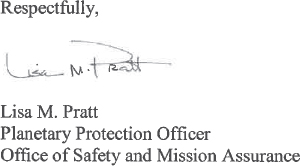B
Revised Request from NASA

David Smith
National Academies of Sciences, Engineering, and Medicine
500 5th Street NW
Washington, DC 2001
Dear David:
In May 2017, NASA asked the National Academies to establish an ad hoc committee to review and assess recent research sponsored by NASA and ESA, relating to the planetary protection concern that hypothetic Martian life might exist on the surface of the Martian moons, Phobos and Deimos, consequent to their ejection from the surface of Mars following a major impact event.
The Technical Point of Contact for this effort is the Planetary Protection Officer at NASA, which has recently changed from Catherine A. Conley to Lisa M. Pratt, who has reviewed the original statement of task and the timeline to completion. The National Academies’ committee has not completed its work and the Japanese Aerospace Exploration Agency (JAXA) has established a second committee to consider whether missions returning samples from Phobos and/or Deimos should be classified as “restricted” or “unrestricted.” Consequently, the National Academies committee is asked to address the following three tasks in addition to the original three tasks. In recognition of the likelihood that developing responses to the additional task will require an additional face-to-face committee meeting, NASA requests the final report be submitted by the end of calendar year 2018.
Addendum to statement of task for Martian Moons Study
- In what specific ways is classification of sample return from Deimos a different case than sample return from Phobos?
- What relevant information for classification of sample return is available from published studies of Martian meteorites on Earth?
- What are the planetary protection consequences of taking a surface sample at depths of 0-2 cm versus taking a sample extending down to depths of 2-10 cm or deeper?



